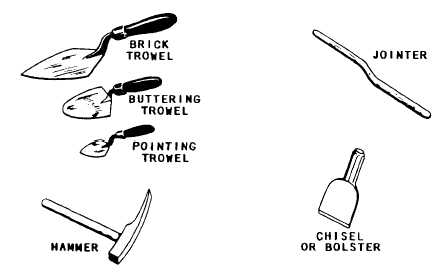CHAPTER 8 MASONRY
Originally, masonry was the art of building a structure from stone. Today, it refers to construction consisting of units held together with mortar, such as concrete block, stone, brick, clay tile products, and, sometimes, glass block. The characteristics of masonry work are determined by the properties of the masonry units and mortar and by the methods of bonding, reinforcing, anchoring, tying, and joining the units into a structure.
MASONRY TOOLS AND EQUIPMENT
LEARNING OBJECTIVE: Upon completing this section, you should be able to identify the basic masonry tools and equipment.
Masonry involves the use of a wide selection of tools and equipment. A set of basic mason's tools, including trowels, a chisel, hammer, and a jointer, is shown in figure 8-1.
TROWELS
A trowel (figure 8-1) is used to pick up mortar from the board, throw mortar on the unit, spread the mortar, and tap the unit down into the bed. A common trowel is usually triangular, ranging in size up to about 11 inches long and from 4 to 8 inches wide. Generally, short, wide trowels are best because they do not put too much strain on the wrist. Trowels used to point and strike joints are smaller, ranging from 3 to 6 inches long and 2 to 3 inches wide. We will talk more about pointing and striking joints later in the chapter.
CHISEL
A chisel (figure 8-1) is used to cut masonry units into parts. A typical chisel is 2 1/2 to 4 1/2 inches wide.
HAMMER
A mason's hammer (figure 8-1) has a square face on one end and a long chisel on the other. The hammer weighs from 1 1/2 to 3 1/2 pounds. You use it to split and rough-break masonry units.

Figure 8-1.-Basic mason's tools.
Continue Reading